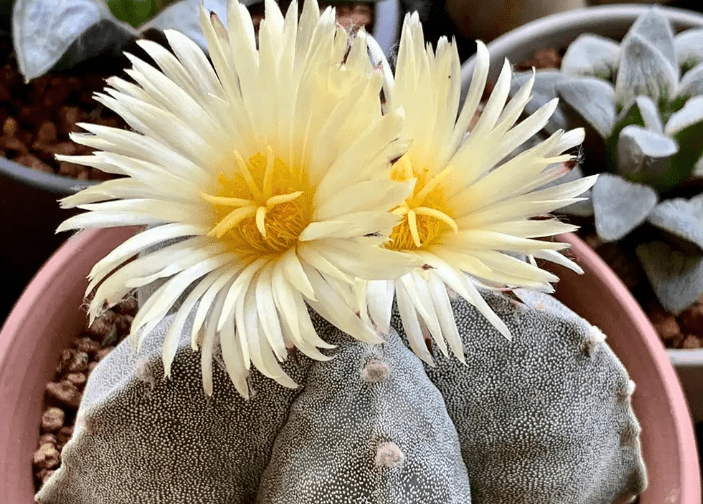
A typical bishop’s cap cactus has a maximum height of 100 cm (39 inches) and a maximum diameter of 20 cm (8 inches). When young, there are four or five distinct ribs, but as it gets older, there are eight or more. Growing more ribs causes the plant, which is initially globose, to become cylindroid. White flecks are scattered throughout the grayish-green flesh. The numerous petals of the fragrant yellow blooms bloom in early spring or the daytime in the summer.
The mature form of this star cactus has fragrant yellow flowers and has white, hair-like extensions in place of spines. In order to make things clear, the genus name “Astrophytum,” which is Latin for “star plant,” was chosen. In both indoor and outdoor pots, Bishop’s cap cacti are thought to be relatively simple to grow.
Care Guide
Water
The Bishop’s cap cactus is a drought-resistant plant that doesn’t need to be watered frequently. When the soil is entirely dry, water it well. To prevent water buildup when watering a pot, water carefully, wait for water to trickle out the bottom, and then pour the extra water from the tray.
Its three main growing seasons are spring, summer and autumn. To keep the soil just a little bit moist, water once or twice every week. Water the soil only enough to prevent it from drying out too much over the winter, usually once a week. Additionally, use distilled or rainwater instead of tap water.
Magnesium, calcium and other mineral salts are abundant in tap water. Compaction of the soil is often brought on by prolonged use. When watering, avoid sprinkling water on the stem to avoid rotting.

Fertilizer
Bishop’s cap cactus should get monthly applications of liquid fertilizer during the growing seasons (spring, summer and autumn). Wintertime doesn’t call for fertilizer. When repotting in the spring or autumn, a tiny amount of slow-release fertilizer can be thoroughly incorporated into the soil.
Use nitrogen fertilizer during seedling and phosphate-potassium fertilizer before and after blooming. The fertilizer concentration ought to be as low as possible. A low concentration of fertilizer applied several times would be better to a high concentration. Excessive fertilizer may be to blame if the base is yellow and develops slowly. Fertilization needs to be halted right quickly in this situation.
Sunlight
As a heliophilic plant, the bishop’s cap cactus requires enough sunlight for it to grow and blossom. It may be positioned on a balcony or in an open area of a garden. However, prolonged exposure to intense sunlight should be avoided in the sweltering summer, when it needs to be shaded or somewhat chilled to prevent damage from high temperatures.
Pruning
Pruning Bishop’s cap cactus is not necessary very often. Remove dead branches and blooms to allow the plant to focus its resources on nutrient-rich growth.
Soil
The Bishop’s Cap Cactus thrives in a pH range of 6-7, fertile, gravel-rich, water-permeable soil. 60% vermiculite + 20% sandy soil+ 20% coco coir or peat moss is a common culture soil composition. You might also add a tiny bit of organic potting soil. To increase the soil’s air permeability, lightweight culture media like vermiculite can be applied. To improve soil fertility, you can also add eggshell powder or vermicompost.
Bishop’s cap cactus roots are extremely sensitive to low oxygen levels. Root rot may develop if the soil is not sufficiently permeable to air and water.
Temperature
Bishop’s cap cacti are found in tropical, subtropical, and semi-arid areas that experience little precipitation, intense sunlight, and scorching temperatures. 20 to 35 °C is the ideal temperature for growth. Temperatures below 10 °C or above 35 °C cause development to stall and dormancy to start. The surroundings should be well-ventilated and the air humidity shouldn’t be too high. Avoid accumulating water and high humidity.
Table





